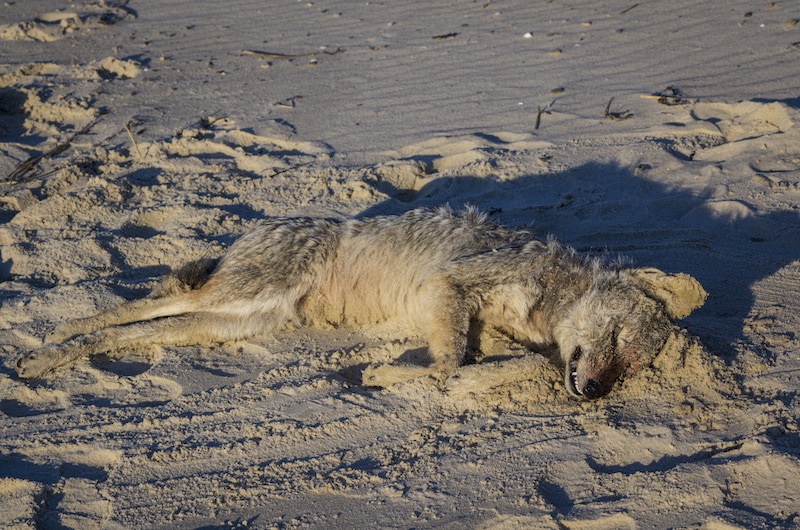Out for a walk on Lambert’s Cove Beach Friday, Ebba Hierta and Chuck Hodgkinson made a surprising discovery: a dead coyote, close enough to the water that waves lapped over it.
The discovery of the coyote raised some questions — namely, where did the animal come from? It has also reignited long-standing lore that one or more coyotes live here on the Vineyard.
In this case, it seems, the coyote was almost certainly not from the Island.
Ms. Hierta and Mr. Hodgkinson at first thought the mysterious animal on the beach was a seal, but a closer look convinced Ms. Hierta that it was a coyote. She went home to get a camera and some gloves while Mr. Hodgkinson pulled the coyote onto the beach so it wouldn’t float away with the tide.
The couple sent pictures to Felix Neck Wildlife Sanctuary, and director Suzan Bellincampi confirmed it was a coyote.
The coyote, a female, was water-logged and found in the swash zone, Ms. Bellincampi said, and weighed about 35 pounds.
Coyotes live everywhere in Massachusetts except Martha’s Vineyard and Nantucket. Their habitat includes Cape Cod, where they arrived in about 2000, and the Elizabeth Islands, where they arrived in the late 1980s.
This is not the first coyote to wash up on the Vineyard. In 1996 there was a report of a drowned coyote washing up on the North Shore of the Vineyard--a sighting documented in a New York Times article. Another coyote washed up on the North Shore in 2004.
While Ms. Bellincampi said it is impossible to know exactly how this coyote ended up on a Vineyard beach, she guesses that she swam over and drowned.
“It could be anything. It could be hypothermia, it could be drowning. It’s very cold, the water’s very cold,” Ms. Bellincampi said. “I don’t know. I wasn’t out there.”
The Elizabeth Islands, just across the water from the Vineyard’s North Shore, are a likely origin.
“It makes sense,” Ms. Bellincampi said. “They do swim.”
The coyote has been salvaged and is no longer on the beach.
There has long been speculation about whether coyotes, or even a single coyote, live on the Vineyard. In 2010, an analysis of scat found up-Island came back a 97 per cent match for coyote. This led many on the Vineyard, including naturalist Gus Ben David, to believe there was at least one coyote on the Island.
Mr. Ben David said Monday that have been credible sightings and evidence of coyotes in past years, including one animal captured on a motion camera. He said there has yet to be a live coyote caught or killed on the Island, and he has not heard reports of sightings over the past several years.
“Do we have a population here on the Vineyard, do we have animals living here? I would say no,” Mr. Ben David said. “It’s not impossible that there could be one or two individuals, but right now I would say unlikely.”
He, too, said it was a mystery why a coyote would wash ashore here. He said canines have been proven to swim long distances, but “animals don’t look out over the water and contemplate, I’m going to swim over there and get a better life,” he said.
As for live coyotes on the Island, the possibility causes concern because they are “opportunistic feeders,” Ms. Bellincampi said, and pose a danger to agriculture and pets.
Ms. Bellincampi noted there have been credible sightings. “To our knowledge there’s no breeding population,” she added
The possibility of a coyote population causes concern because they are “opportunistic feeders,” she said, posing a danger to agriculture and pets.
“It’s always possible that one will eventually make it’s way here,” Ms. Bellincampi said, which would have “serious implications for a lot of our wildlife.”
Ms. Hierta said that because of the coyote buzz on the Island, she wasn’t that surprised to see the one they found on the beach Friday.
“I know there had been talk about them a few years back, some farmers thought they saw them and they were pretty sure about that,” Ms. Hierta said. “We know they get here somehow, so what surprised us was what good condition it looked like it was in.” She said the coyote was not terribly thin and looked fairly healthy. “We’re assuming it drowned.”
The discovery also turned an otherwise ordinary beach walk into something more memorable.
“Usually you’ll find some pretty stones or shells,” Ms. Hierta said. “It’s very unusual to find a coyote.”







Comments (16)
Comments
Comment policy »